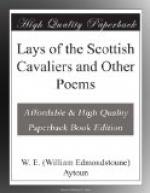“They brought him to the Watergate,”—p. 36.
“Friday, 17th May.—Act ordaining James Grahame to be brought from the Watergate on a cart, bareheaded, the hangman in his livery, covered, riding on the horse that draws the cart—the prisoner to be bound to the cart with a rope—to the Tolbooth of Edinburgh, and from thence to be brought to the Parliament House, and there, in the place of delinquents, on his knees, to receive his sentence—viz., to be hanged on a gibbet at the Cross of Edinburgh, with his book and declaration tied on a rope about his neck, and there to hang for the space of three hours until he be dead; and thereafter to be cut down by the hangman, his head, hands, and legs to be cut off, and distributed as follows—viz., his head to be affixed on an iron pin, and set on the pinnacle of the west gavel of the new prison of Edinburgh; one hand to be set on the port of Perth, the other on the port of Stirling; one leg and foot on the port of Aberdeen, the other on the port of Glasgow. If at his death penitent, and relaxed from excommunication, then the trunk of his body to be interred, by pioneers, in the Greyfriars; otherwise, to be interred in the Boroughmuir, by the hangman’s men, under the gallows.”—BALFOUR’S Notes of Parliament.
It is needless to remark that this inhuman sentence was executed to the letter. In order that the exposure might be more complete, the cart was constructed with a high chair in the centre, having holes behind, through which the ropes that fastened him were drawn. The author of the Wigton Papers, recently published by the Maitland Club, says, “The reason of his being tied to the cart was in hope that the people would have stoned him, and that he might not be able by his hands to save his face.” His hat was then pulled off by the hangman and the procession commenced.
“But when he came, though pale
and wan,
He looked so great
and high,”—p. 37.
“In all the way, there appeared in him such majesty, courage, modesty—and even somewhat more than natural—that those common women who had lost their husbands and children in his wars, and who were hired to stone him, were upon the sight of him so astonished and moved, that their intended curses turned into tears and prayers; so that next day all the ministers preached against them for not stoning and reviling him.”—Wigton Papers.




